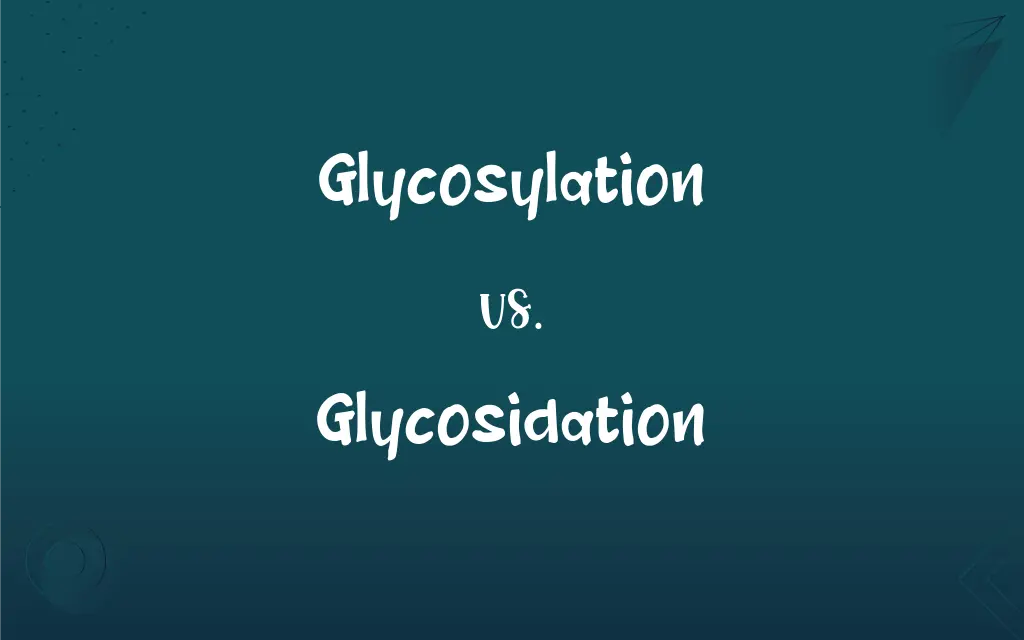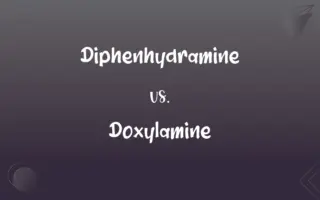Glycosylation vs. Glycosidation: What's the Difference?
Edited by Aimie Carlson || By Janet White || Published on January 13, 2024
Glycosylation is a biochemical process of attaching sugar molecules to proteins or lipids. Glycosidation is a chemical reaction forming glycosides, typically involving sugars and other molecules.

Key Differences
Glycosylation is a vital biological process where sugars are enzymatically attached to proteins or lipids, altering their function and stability. Glycosidation, on the other hand, refers to the chemical synthesis of glycosides, compounds formed by attaching a sugar to another functional group.
In glycosylation, sugars like glucose or mannose are commonly added to proteins or lipids, impacting cell signaling and immune response. Glycosidation is a broader chemical reaction, often involving the formation of protective or storage forms of sugars in plants and other organisms.
Glycosylation occurs in the endoplasmic reticulum and Golgi apparatus of cells, playing a critical role in protein folding and trafficking. Glycosidation reactions are not limited to biological systems but are also used in pharmaceutical and chemical industries for synthesizing various compounds.
Enzymes called glycosyltransferases are responsible for glycosylation, ensuring specificity and efficiency in this process. Glycosidation, in contrast, can occur under various conditions and does not always require enzymes, often being facilitated by acids or bases in a laboratory setting.
Glycosylation can be N-linked or O-linked, depending on the attachment site on the target molecule. Glycosidation results in diverse compounds, including flavonoids and saponins, important in plant defense and human nutrition.
ADVERTISEMENT
Comparison Chart
Definition
Enzymatic addition of sugars to proteins or lipids
Chemical reaction forming glycosides
Biological Role
Protein folding, cell signaling, immune response
Formation of protective/storage forms of sugars
Occurrence
In cells, specifically ER and Golgi apparatus
In biological and chemical synthesis
Enzymatic Requirement
Requires glycosyltransferases
May not require enzymes, often chemically driven
Types of Compounds Involved
Proteins, lipids, and sugars like glucose, mannose
Sugars and various other functional groups
ADVERTISEMENT
Glycosylation and Glycosidation Definitions
Glycosylation
Glycosylation is the attachment of sugar molecules to proteins or lipids.
Glycosylation of antibodies enhances their ability to detect pathogens.
Glycosidation
Glycosidation is the formation of glycosides through chemical reactions.
Glycosidation is used in synthesizing certain pharmaceutical drugs.
Glycosylation
It plays a key role in protein folding and cellular functions.
Abnormal glycosylation can lead to various diseases.
Glycosidation
This process can occur both biologically and synthetically.
Glycosidation is key in producing flavor compounds in fruits.
Glycosylation
This process can affect a molecule's stability and activity.
Glycosylation is crucial for the effective functioning of enzymes.
Glycosidation
It involves attaching a sugar molecule to another functional group.
Glycosidation reactions create diverse plant metabolites.
Glycosylation
Glycosylation occurs in the endoplasmic reticulum and Golgi apparatus.
The glycosylation of hormones regulates their release and activity.
Glycosidation
Glycosidation does not necessarily require enzymatic action.
In the lab, glycosidation can be facilitated by acids or bases.
Glycosylation
It involves enzymes called glycosyltransferases.
Glycosylation patterns can be studied to understand disease mechanisms.
Glycosidation
It results in compounds like flavonoids and saponins.
Glycosidation contributes to the medicinal properties of some plants.
Glycosylation
The addition of saccharides to proteins or lipids to form a glycoprotein or glycolipid.
Glycosidation
The formation of a glycoside; glycosylation.
Glycosylation
(organic chemistry) The reaction of a saccharide with a hydroxy or amino functional group to form a glycoside; especially the reaction with a protein or lipid to form a glycoprotein or glycolipid.
FAQs
What is glycosidation?
Glycosidation is the chemical reaction to form glycosides, involving sugars and other molecules.
Are enzymes involved in glycosidation?
Not necessarily; it can be a non-enzymatic chemical reaction.
What is the biological significance of glycosylation?
It's critical for protein folding, stability, and cell signaling.
What enzymes facilitate glycosylation?
Glycosyltransferases.
Can glycosidation occur in a lab setting?
Yes, it's used in chemical and pharmaceutical synthesis.
Where does glycosylation occur in the cell?
In the endoplasmic reticulum and Golgi apparatus.
How does glycosylation affect protein function?
It can alter protein activity, stability, and cellular location.
What is glycosylation?
Glycosylation is the enzymatic process of adding sugar molecules to proteins or lipids.
Is glycosidation important in plant biology?
Yes, it's involved in forming protective or storage forms of sugars in plants.
Can glycosidation produce flavor compounds?
Yes, especially in fruits and plants.
Are glycosidation reactions used in food industry?
Yes, for flavor enhancement and preservation.
Does glycosylation occur in all cells?
It's prevalent in eukaryotic cells, especially in those secreting proteins.
What types of compounds are formed by glycosidation?
Glycosides, including flavonoids and saponins.
Does glycosidation have pharmaceutical applications?
Yes, in drug synthesis and modification.
Are there different types of glycosylation?
Yes, including N-linked and O-linked glycosylation.
What's the difference between glycosylation and glycosidation?
Glycosylation is an enzymatic cell process, while glycosidation is a broader chemical reaction.
Is glycosidation important in natural product chemistry?
Yes, for synthesizing bioactive compounds.
Is glycosylation reversible?
No, it's a stable modification.
Can glycosylation patterns be used to diagnose diseases?
Yes, abnormal patterns can indicate certain diseases.
What's the role of glycosidation in plant defense?
It helps in forming compounds like saponins that defend against pathogens.
About Author
Written by
Janet WhiteJanet White has been an esteemed writer and blogger for Difference Wiki. Holding a Master's degree in Science and Medical Journalism from the prestigious Boston University, she has consistently demonstrated her expertise and passion for her field. When she's not immersed in her work, Janet relishes her time exercising, delving into a good book, and cherishing moments with friends and family.
Edited by
Aimie CarlsonAimie Carlson, holding a master's degree in English literature, is a fervent English language enthusiast. She lends her writing talents to Difference Wiki, a prominent website that specializes in comparisons, offering readers insightful analyses that both captivate and inform.






































































